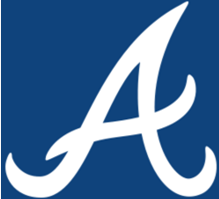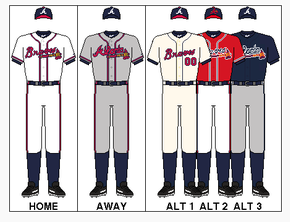
Atlanta Braves
USINFO | 2013-06-20 10:34
| Atlanta Braves | |||||
| 2013 Atlanta Braves season | |||||
| Established | 1870 | ||||
| Based in Atlanta since 1966 | |||||
|
|||||
| Major league affiliations | |||||
|
National League (1876–present) East Division (1994–present) |
|||||
| Current uniform | |||||
|
|||||
| Retired numbers | 3 · 6 · 21 · 29 ·31 · 35 · 41 ·42 · 44 · 47 | ||||
| Colors | |||||
|
Navy, Scarlet, White |
|||||
| Name | |||||
| Atlanta Braves (1966–present) | |||||
|
Milwaukee Braves (1953 - 1965) Boston Braves (1941 - 1952) Boston Bees (1936 - 1940) Boston Braves (1912 - 1935) Boston Rustlers (1911) Boston Doves (1907 - 1910) Boston Beaneaters (1883 - 1906) Boston Red Stockings (1876 - 1882) |
|||||
| Other nicknames | |||||
| The Bravos, The Team of the 90s, America's Team | |||||
| Ballpark | |||||
|
Turner Field (1997–present) Atlanta-Fulton County Stadium (1966–1996) a.k.a. Atlanta Stadium (1966–1976) Milwaukee County Stadium (1953–1965) Braves Field (1915–1952) a.k.a. National League Park (1936–1941) Fenway Park (1914–1915) South End Grounds (1894–1914) Congress Street Grounds (1894) South End Grounds (1871–1894) |
|||||
The Atlanta Braves are a professional baseball team based in Atlanta. The Braves are a member of the Eastern Division of Major League Baseball's National League. The Braves have played in Turner Field since 1997.
The "Braves" name, which was first used in 1912, originates from a term for a Native American warrior. They are nicknamed "the Bravos", and often referred to as "America's Team" in reference to the team's games being broadcast on the nationally available TBS from the 1970s until 2007, gaining a wide fanbase.
From 1991 to 2005 the Braves were one of the most successful franchises in baseball, winning division titles an unprecedented 14 consecutive times in that period[1][2] (omitting thestrike-shortened 1994 season in which there were no official division champions). The Braves won the NL West 1991–93 and the NL East 1995–2005, and returned to the playoffs as the National League Wild Card in 2010. The Braves advanced to the World Series five times in the 1990s, winning the title in 1995. Since their debut in the National League in 1876, the franchise has won 16 divisional titles, 17 National League pennants, as well as three World Series championships—in 1914 as the Boston Braves, in 1957 as the Milwaukee Braves, and in 1995 in Atlanta. The Braves are the only Major League Baseball franchise to have won the World Series in three different home cities.
The club is one of the National League's two remaining charter franchises (the other being the Chicago Cubs) and was founded in Boston, Massachusetts, in 1871 as the Boston Red Stockings (not to be confused with the American League's Boston Red Sox). They are considered "the oldest continuously playing team in major North American sports."[3] There is an argument as to who is actually older because although the Cubs are a full season "older" (formed as the Chicago White Stockings in 1870) Chicago lost two seasons to the Great Chicago Fire, thus the Braves have played more consecutive seasons.
After various name changes, such as the Boston Beaneaters, the team operated as the Boston Braves for most of the first half of the 20th century. In 1953, the team moved toMilwaukee, Wisconsin and became the Milwaukee Braves, followed by the move to Atlanta in 1966. The team's tenure in Atlanta is famous for Hank Aaron breaking Babe Ruth's career home run record in 1974, though the majority of Aaron's home runs were hit while the team was in Milwaukee. His record stood until 2007, when San Francisco left fielder Barry Bondsbroke the record.[4]
History
Main article: History of the Atlanta Braves
Boston
Main article: History of the Boston Braves
1870–1913
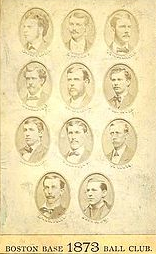
The Cincinnati Red Stockings, established in 1869 as the first professional baseball team, voted to dissolve after the 1870 season. Player-manager Harry Wright then went to Boston, Massachusetts, at the invitation of Boston Red Stockings founder Ivers Whitney Adams, with brother George and two other Cincinnati players, to form the nucleus of the Boston Red Stockings, a charter member of the National Association of Professional Base Ball Players(NAPBBP). The original Boston Red Stockings team and its successors can lay claim to being the oldest continuously playing team in American professional sports.[5] (The only other team that has been organized as long, the Chicago Cubs, did not play for the two years following the Great Chicago Fire of 1871.) Two young players hired away from the Forest City club of Rockford, Illinois, turned out to be the biggest stars during the NAPBBP years: pitcherAl Spalding (founder of Spalding sporting goods) and second baseman Ross Barnes.
Led by the Wright brothers, Barnes, and Spalding, the Red Stockings dominated the National Association, winning four of that league's five championships. The team became one of the National League's charter franchises in 1876, sometimes called the "Red Caps" (as a new Cincinnati Red Stockings club was another charter member). Boston came to be called the Beaneaters in 1883, while retaining red as the team color.
The Boston Red Caps played in the first game in the history of the National League, on Saturday, April 22, 1876, defeating the Athletics, 6-5.[6][7]
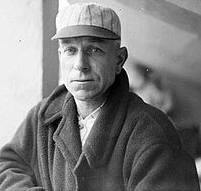
Hugh Duffy played with the franchise from 1892–1900 and won the third Triple Crown in MLB history
Although somewhat stripped of talent in the National League's inaugural year, Boston bounced back to win the 1877 and 1878 pennants. The Red Caps/Beaneaters were one of the league's dominant teams during the 19th century, winning a total of eight pennants. For most of that time, their managerwas Frank Selee. The 1898 team finished 102–47, a club record for wins that would stand for almost a century. Stars of those 1890s Beaneater teams included the "Heavenly Twins", Hugh Duffy and Tommy McCarthy, as well as "Slidin'" Billy Hamilton.
The team was decimated when the American League's new Boston entry set up shop in 1901. Many of the Beaneaters' stars jumped to the new team, which offered contracts that the Beaneaters' owners did not even bother to match. They only managed one winning season from 1900 to 1913, and lost 100 games five times. In 1907, the Beaneaters (temporarily) eliminated the last bit of red from their stockings because their manager thought the red dye could cause wounds to become infected (as noted in The Sporting News Baseball Guide during the 1940s when each team's entry had a history of its nickname(s). See details inHistory of baseball team nicknames). The American League club's owner, Charles Taylor, wasted little time in adopting Red Sox as his team's first official nickname (up to that point they had been called by the generic "Americans"). Media-driven nickname changes to the Doves in 1907 and the Rustlers in 1911 did nothing to change the National League club's luck. The team became the Braves for the first time in 1912. Their owner, James Gaffney, was a member of New York City's political machine, Tammany Hall, which used an Indian chief as their symbol.
1914: Miracle
Main article: 1914 Boston Braves season
Two years later, the Braves put together one of the most memorable seasons in baseball history. After a dismal 4–18 start, the Braves seemed to be on pace for a last place finish. On July 4, 1914, the Braves lost both games of a doubleheader to the Brooklyn Dodgers. The consecutive losses put their record at 26–40 and the Braves were in last place, 15 games behind the league-leading New York Giants, who had won the previous three league pennants. After a day off, the Braves started to put together a hot streak, and from July 6 through September 5, the Braves went 41–12.[8] On September 7 and 8, the Braves took two of three from the New York Giants and moved into first place. The Braves tore through September and early October, closing with 25 wins against six losses, while the Giants went 16–16.[9]They were the only team, under the old eight-team league format, to win a pennant after being in last place on the Fourth of July. They were in last place as late as July 18, but were close to the pack, moving into fourth on July 21 and second place on August 12.[10]
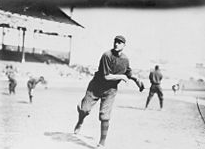
Despite their amazing comeback, the Braves entered the World Series as a heavy underdog to Connie Mack's Philadelphia A's. Nevertheless, the Braves swept the Athletics—the first unqualified sweep in the young history of the modern World Series (the 1907 Series had one tied game) to win the world championship. Meanwhile, Johnny Everswon the Chalmers Award.
The Braves played the World Series (as well as the last few games of the 1914 season) at Fenway Park, since their normal home, the South End Grounds, was too small. However, the Braves' success inspired owner Gaffney to build a modern park, Braves Field, which opened in August 1915. It was the largest park in the majors at the time, with 40,000 seats and a very spacious outfield. The park was novel for its time; public transportation brought fans right to the park.
1915–1953
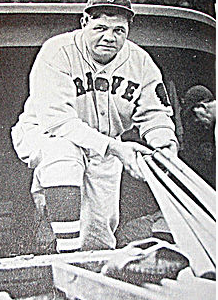
After contending for most of 1915 and 1916, the Braves only twice posted winning records from 1917 to 1932. The lone highlight of those years came when Judge Emil Fuchs bought the team in 1923 to bring his longtime friend, pitching great Christy Mathewson, back into the game. However, Mathewson died in 1925, leaving Fuchs in control of the team.
Fuchs was committed to building a winner, but the damage from the years prior to his arrival took some time to overcome. The Braves finally managed to be competitive in 1933 and 1934 under manager Bill McKechnie, but Fuchs' revenue was severely depleted due to the Great Depression.
Looking for a way to get more fans and more money, Fuchs worked out a deal with the New York Yankees to acquire Babe Ruth, who had started his career with the Red Sox. Fuchs made Ruth team vice president, and promised him a share of the profits. He was also granted the title of assistant manager, and was to be consulted on all of the Braves' deals. Fuchs even suggested that Ruth, who had long had his heart set on managing, could take over as manager once McKechnie stepped down—perhaps as early as 1936.[11]
At first, it appeared that Ruth was the final piece the team needed in 1935. On opening day, he had a hand in all of the Braves' runs in a 4–2 win over the Giants. However, that proved to be the only time the Braves were over .500 all year. Events went downhill quickly. While Ruth could still hit, he could do little else. He could not run, and his fielding was so terrible that three of the Braves' pitchers threatened to go on strike if Ruth were in the lineup. It soon became obvious that he was vice president and assistant manager in name only and Fuchs' promise of a share of team profits was hot air. In fact, Ruth discovered that Fuchs expected him to invest some of his money in the team.[11]
Seeing a franchise in complete disarray, Ruth retired on June 1—only six days after he clouted what turned out to be the last three home runs of his career. He had wanted to quit as early as May 12, but Fuchs wanted him to hang on so he could play in every National League park.[11] The Braves finished 38–115, the worst season in franchise history. Their .248 winning percentage is the third-worst in baseball history, and the second-worst in National League history (behind only the 1899 Cleveland Spiders).
Fuchs lost control of the team in August 1935,[11] and the new owners tried to change the team's image by renaming it the Boston Bees. This did little to change the team's fortunes. After five uneven years, a new owner, construction magnate Lou Perini, changed the nickname back to the Braves. He immediately set about rebuilding the team. World War II slowed things down a little, but the team rode the pitching of Warren Spahn to impressive seasons in 1946 and 1947.
In 1948, the team won the pennant, behind the pitching of Spahn and Johnny Sain, who won 39 games between them. The remainder of the rotation was so thin that in September, Boston Post writer Gerald Hern wrote this poem about the pair:
First we'll use Spahn
then we'll use Sain
Then an off day
followed by rain
Back will come Spahn
followed by Sain
And followed
we hope
by two days of rain.
Milwaukee (1953–1965)
See also: History of the Atlanta Braves #Milwaukee
Milwaukee went wild over the Braves, who were welcomed as genuine heroes. The Braves finished 92–62 in their first season in Milwaukee, and drew a then-NL record 1.8 million fans. The success of the team was noted by many owners. Not coincidentally, the Philadelphia Athletics, St. Louis Browns, Brooklyn Dodgers and New York Giants would leave their original hometowns in the next five years.

As the 1950s progressed, the reinvigorated Braves became increasingly competitive. Sluggers Eddie Mathews and Hank Aaron drove the offense (they would hit a combined 1,226 home runs as Braves, with 850 of those coming while the franchise was in Milwaukee), while Spahn, Lew Burdette and Bob Buhl anchored the rotation. The 1956 Braves finished second, only one game behind the Brooklyn Dodgers.
In 1957, the Braves celebrated their first pennant in nine years spearheaded by Aaron's MVP season, as he led the National League in home runs and RBI. Perhaps the most memorable of his 44 round-trippers that season came on September 23, a two-run walk-off home run that gave the Braves a 4–2 victory over the St. Louis Cardinals and clinched the League championship. The team then went on to its first World Series win in over 40 years, defeating the New York Yankees of Berra, Mantle, and Ford in seven games. Burdette, the Series MVP, threw three complete game victories, giving up only two earned runs.
In 1958, the Braves again won the National League pennant and jumped out to a three games to one lead in the World Series against the New York Yankees once more, thanks in part to the strength of Spahn's and Burdette's pitching. But the Yankees stormed back to take the last three games, in large part to World Series MVP Bob Turley's pitching.
The 1959 season saw the Braves finish the season in a tie with the Los Angeles Dodgers. Many residents of Chicago and Milwaukee were hoping for a Sox-Braves Series, as the cities are only about 75 miles (121 km) apart, but it was not to be because Milwaukee fell in a best-of-3 playoff with two straight losses to the Dodgers. The Dodgers would go on to defeat the Chicago White Sox in the World Series.
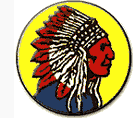
The next six years were up-and-down for the Braves. The 1960 season featured two no-hitters by Burdette and Spahn, and Milwaukee finished seven games behind the Pittsburgh Pirates, who ultimately were to win the World Series that year, in second place, one year after the Braves were on the winning end of the 13-inning near-perfect game of Pirates pitcher Harvey Haddix. The 1961 season saw a drop in the standings for the Braves down to fourth, despite Spahn recording his 300th victory and pitching another no-hitter that year.
Aaron hit 45 home runs in 1962, a Milwaukee career high for him, but this did not translate into wins for the Braves, as they finished fifth. The next season, Aaron again hit 44 home runs and notched 130 RBI, and Spahn was once again the ace of the staff, going 23–7. However, none of the other Braves produced at that level, and the team finished in the lower half of the league, or "second division", for the first time in its short history in Milwaukee.
The Braves were somewhat mediocre as the 1960s began, but fattened up on the expansion New York Mets and Houston Colt .45s. To this day, the Milwaukee Braves are the only major league team who played more than one season and never had a losing record.
Perini sold the Braves to a Chicago-based group led by William Bartholomay in 1962. Almost immediately Bartholomay started shopping the Braves to a larger television market. Keen to attract them, the fast-growing city of Atlanta, led by Mayor Ivan Allen, constructed a new $18 million, 52,000-seat ballpark in less than one year, Atlanta Stadium, which was officially opened in 1965 in hopes of luring an existing major league baseball and/or NFL/AFL team. After the city failed to lure the Kansas City A's to Atlanta (the A's would move to Oakland in 1968), the Braves announced their intention to move to Atlanta for the 1965 season. However, an injunction filed in Wisconsin kept the Braves in Milwaukee for one final year. In 1966, the Braves completed the move to Atlanta.
Eddie Mathews is the only Braves player to have played for the organization in all three cities that they have been based in. Mathews played with the Braves for their last season in Boston, the team's entire tenure in Milwaukee, and their first season in Atlanta.
Atlanta
1966–1974
The Braves were a .500 team in their first few years in Atlanta; 85–77 in 1966, 77–85 in 1967, and 81–81 in 1968. The 1967 season was the Braves' first losing season since 1952, their last year in Boston. In 1969, with the onset of divisional play, the Braves won the first-ever National League West Division title, before being swept by the "Miracle Mets" in the National League Championship Series. They would not be a factor during the next decade, posting only two winning seasons between 1970 and 1981 – in some cases, fielding teams as bad as the worst Boston teams.
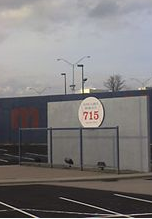
The fence over which Hank Aaron hit his 715th career home run still exists outside of Turner Field.
In the meantime, fans had to be satisfied with the achievements of Hank Aaron. In the relatively hitter-friendly confines and higher-than-average altitude of Atlanta Stadium ("The Launching Pad"), he actually increased his offensive production. Atlanta also produced batting champions in Rico Carty (in 1970) and Ralph Garr (in 1974). In the shadow of Aaron's historical home run pursuit, was the fact that three Atlanta sluggers hit 40 or more home runs in 1973 – Darrell Evans, Davey Johnson and, of course, Aaron.
By the end of the 1973 season, Aaron had hit 713 home runs, one short of Ruth's record. Throughout the winter he received racially motivated death threats, but stood up well under the pressure. The next season, it was only a matter of time before he set a new record. On April 4, opening day, he hit No.714 in Cincinnati, and on April 8, in front of his home fans and a national television audience he finally beat Ruth's mark with a home run to left-center field off left-hander Al Downing of the Los Angeles Dodgers. Aaron spent most of his career as a Milwaukee and Atlanta Brave before asking to be traded to the Milwaukee Brewers, while Ruth finished his career as a Boston Brave. In fact, until Barry Bonds eclipsed the 714 home runs hit by Babe Ruth in 2006, the top two home run hitters in Major League history had at one time been Braves.
1976–77: Ted Turner buys the team
Media mogul Ted Turner purchased the team in 1976, and played a large role in the team's operation.
In 1976, the team was purchased by media magnate Ted Turner, owner of superstation WTBS, as a means to keep the team (and one of his main programming staples) in Atlanta. The financially strapped Turner used money already paid to the team for their broadcast rights as a down-payment. It was then that Atlanta Stadium was renamed Atlanta-Fulton County Stadium. Turner quickly gained a reputation as a quirky, hands-on baseball owner. On May 11, 1977, Turner appointed himself manager, but because MLB passed a rule in the 1950s barring managers from holding a financial stake in their teams, Turner was ordered to relinquish that position after one game (the Braves lost 2–1 to the Pittsburgh Pirates to bring their losing streak to 17 games).
Turner used the Braves as a major programming draw for his fledgling cable network, making the Braves the first franchise to have a nationwide audience and fanbase. WTBS marketed the team as "The Atlanta Braves: America's Team", a nickname that still sticks in some areas of the country, especially the South. Among other things, in 1976 Turner suggested the nickname "Channel" for pitcher Andy Messersmith and jersey number 17, in order to promote the television station that aired Braves games. Major League Baseball quickly nixed the idea.
1978–1990
After three straight losing seasons, Bobby Cox was hired for his first stint as manager for the 1978 season. He promoted 22-year-old slugger Dale Murphy into the starting lineup. Murphy hit 77 home runs over the next three seasons but he struggled on defense, unable to adeptly play either catcher or first base. In 1980, Murphy was moved to center field and demonstrated excellent range and throwing ability, while the Braves earned their first winning season since 1974. Cox was fired after the 1981 season and replaced with Joe Torre, under whose leadership the Braves attained their first divisional title since 1969. Strong performances from Bob Horner, Chris Chambliss, pitcher Phil Niekro, and short relief pitcher Gene Garber helped the Braves, but no Brave was more acclaimed than Murphy, who won both a Most Valuable Player and a Gold Glove award. Murphy also won a Most Valuable Player award the following season, but the Braves began a period of decline that defined the team throughout the 1980s. Murphy, excelling in defense, hitting, and running, was consistently recognized as one of the league's best players, but the Braves averaged only 65 wins per season between 1985 and 1990. Their lowest point came in 1988, when they lost 106 games. The 1986 season saw the return of Bobby Cox as general manager. Also in 1986, the team stopped using their Native American-themed mascot, Chief Noc-A-Homa.
1991–2004: Division dominance
1991–1994

Cox returned to the dugout as manager in the middle of the 1990 season, replacing Russ Nixon. The Braves finished the year with the worst record in baseball, at 65–97. They traded Dale Murphy to thePhiladelphia Phillies after it was clear he was becoming a less dominant player. Pitching coach Leo Mazzone began developing young pitchers Tom Glavine, Steve Avery, and John Smoltz into future stars. That same year, the Braves used the number one overall pick in the 1990 MLB Draft to select Chipper Jones, who became one of the best hitters in team history. Perhaps the Braves' most important move was not on the field, but in the front office. Immediately after the season, John Schuerholz was hired away from the Kansas City Royals as general manager.
The following season, Glavine, Avery, and Smoltz would be recognized as the best young pitchers in the league, winning 52 games among them. Meanwhile, behind position players David Justice, Ron Gant and unexpected league Most Valuable Player and batting champion Terry Pendleton, the Braves overcame a 39–40 start, winning 55 of their final 83 games over the last three months of the season and edging theLos Angeles Dodgers by one game in one of baseball's more memorable playoff races. The "Worst to First" Braves, who had not won a divisional title since 1982, captivated the city of Atlanta (and the entire southeast) during their improbable run to the flag. They defeated the Pittsburgh Pirates in a very tightly contested seven-game NLCS only to lose the World Series, also in seven games, to theMinnesota Twins. The series, considered by many to be one of the greatest ever, was the first time a team that had finished last in its division one year went to the World Series the next; both the Twins and Braves accomplished the feat.
Despite the 1991 World Series loss, the Braves' success would continue. In 1992, the Braves returned to the NLCS and once again defeated the Pirates in seven games, culminating in a dramatic game seven win. Francisco Cabrera's two-out single that scored David Justice and Sid Bream capped a three-run rally in the bottom of the ninth inning that gave the Braves a 3–2 victory. It was the first time in post season history that the tying and winning runs had scored on a single play in the ninth inning. The Braves lost the World Series to the Toronto Blue Jays however. In 1993, the Braves signed Cy Young Award winning pitcher Greg Madduxfrom the Chicago Cubs, leading many baseball insiders to declare the team's pitching staff the best in baseball. The 1993 team posted a franchise-best 104 wins after a dramatic pennant race with the San Francisco Giants, who won 103 games. The Braves needed a stunning 55–19 finish to edge out the Giants, who led the Braves by nine games in the standings as late as August 11. However, the Braves fell in the NLCS to the Philadelphia Phillies in six games.
In 1994, in a realignment of the National League's divisions following the 1993 expansion, the Braves moved to the Eastern Division.[12] This realignment was the main cause of the team's heated rivalry with the New York Mets during the mid-to-late 1990s.[13][14][15]
The player's strike cut short the 1994 season, prior to the division championships, with the Braves six games behind the Montreal Expos with 48 games left to play.
1995–2004
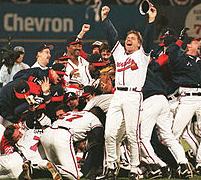
The Braves returned strong the following strike-shortened (144 games instead of the customary 162) year and beat the Cleveland Indians in the 1995 World Series. This squelched claims by many Braves critics that they were the "Buffalo Bills of Baseball" (January 1996 issue of Beckett Baseball Card Monthly). With this World Series victory, the Braves became the first team in Major League Baseball to win world championships in three different cities. With their strong pitching as a constant, the Braves appeared in the 1996 and 1999 World Series (losing both to the New York Yankees, managed by Joe Torre, a former Braves manager),[14] and had a streak of division titles from 1991 to 2005 (three in the Western Division and eleven in the Eastern) interrupted only in 1994 when the strike ended the season early. Pitching was not the only constant in the Braves organization —Cox was the Braves' manager, while Schuerholz remained the team's GM until after the 2007 season when he was promoted to team president. Terry Pendleton finished his playing career elsewhere, but returned to the Braves system as the hitting coach.
Share this page



